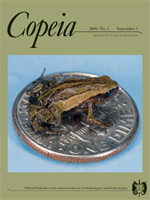In anurans, cutaneous resistance (RS) to evaporative water loss (EWL) correlates with ecological features and is influenced by taxonomic position. For example, bufonids are regarded as exhibiting a permeable skin that seems typical for terrestrial anurans. However, this assumption is supported by information on only four bufonid species; therefore, the enormous ecological diversity of the family remains poorly investigated. To assess whether variation in RS within related bufonids correlates with environmental aridity, we measured area-specific rates of EWL of two Brazilian populations of Rhinella granulosa (previously Bufo granulosus), one from the Atlantic Forest and other from the semi-arid Caatinga, and compared both with the forest species R. ornata. Rhinella granulosa from the Atlantic Forest had higher cutaneous resistance than conspecifics from Caatinga and R. ornata. Rhinella ornata presented the lowest cutaneous resistance values. However, RS were very close to zero in all three populations. We conclude that enhanced RS is not part of the suite of traits allowing R. granulosa to exploit the Caatinga, and that variation in RS within bufonids may relate to traits other than water conservation. Some information on microhabitat occupation and ventral skin morphology supports the idea that exceptional abilities for detecting and taking up water may be the key factors enhancing the survival of R. granulosa, and possibly other bufonids, in xeric environments.
How to translate text using browser tools
3 September 2009
Cutaneous Resistance to Evaporative Water Loss in Brazilian Rhinella (Anura: Bufonidae) from Contrasting Environments
Ivan Prates,
Carlos A. Navas
ACCESS THE FULL ARTICLE

Copeia
Vol. 2009 • No. 3
September 2009
Vol. 2009 • No. 3
September 2009




